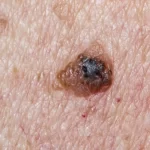The dry air of winter can rob skin of its protective oils and lead to all sorts of unpleasant issues. A visit to your dermatologist can help determine a proper diagnosis and treatment plan. Taking short, lukewarm showers and baths, using a fragrance-free soap, reapplying thick creams and using a humidifier are all good preventive measures.
1. Dry Skin
Dry skin can be uncomfortable and itchy, especially in the winter when humidity is typically low outdoors and indoors with heating systems. Using harsh soaps, aging and certain medical conditions all contribute to the condition. It’s important to moisturize with a non-alcohol-based hand cream or body lotion. Avoid rubbing or scratching the skin, as it can cause further irritation. Limit exposure to cold weather and wear gloves, hats and scarves to protect the skin on your hands.
If your dry skin becomes inflamed, scaly or red, contact your doctor. Inflammation can be a sign of more serious health issues like kidney failure, malnutrition or Sjogren’s syndrome. Use a humidifier in your home to add moisture to the air. Take lukewarm showers or baths and limit the time spent in hot water.
2. Cracked Skin
Dry skin can lead to cracked skin, which is not only unsightly but also a problem because cracks serve as portals for bacteria and viruses to enter the body. Cracked skin can result from a number of things, including the cold weather, low humidity, and hot showers or baths that strip the skin of its natural oils.
Drinking plenty of water is the best preventative measure. The body uses the water it does have for essential functions, but if you drink enough, your skin has the moisture it needs to stay healthy.
Applying moisturizers often is a good way to prevent cracked skin. Use an ointment and be sure to apply it right after you wash your hands or take a shower or bath. Try using a product that contains the active ingredient lactic acid, found in fermented dairy products like yogurt and cheese.
3. Eczema
While eczema can flare up at any time of year, it’s particularly challenging in winter. Dry skin irritates this condition, which causes red, scaly patches of itchy, inflamed skin.
Itchy eczema can trigger a vicious cycle of scratching, which can make the affected areas worse. If you suffer from this skin condition, talk to a dermatologist for a proper diagnosis.
To prevent eczema flares, moisturize with thick creams or even ointments. Avoid irritants, such as antibacterial soaps, harsh detergents and hand sanitizers. If you live in a dry climate, use a humidifier to add moisture to the air. Wear loose, breathable fabrics and choose cotton for your bed linens. And keep sweat under control — salt in the perspiration dries out the skin. Consider eating foods rich in vitamin D, which may reduce eczema symptoms.
4. Psoriasis
Many psoriasis sufferers find their symptoms worsen during the winter due to cold weather, stress, and social events with friends who may be sick. These factors can cause a temporary flare-up of itchy, flaky patches of scaly skin that appear on the knees, elbows, and scalp.
The dry winter air can aggravate your psoriasis by stripping your skin of its natural moisture. So, make sure to moisturize more often with a thick cream and use a humidifier in your home.
Remember, frequent hand washing and sanitizer use this pandemic year can also make your skin drier, especially if you have a condition like psoriasis. So, choose soaps and body washes with emollient ingredients that are fragrance free. Make a habit of moisturizing after each shower and reapply throughout the day.
5. Allergies
When skin comes into contact with an allergen, such as pollen, chemicals or proteins found in foods or medications, the immune system triggers an allergic reaction. This results in symptoms, like itchiness, redness and swelling, hives, and the condition known as dermatitis. Your healthcare provider can use a skin prick test, patch tests or blood tests to diagnose a suspected allergy and provide treatment.
The largest distinction between winter allergies and spring or summer ones is that they are not triggered by outdoor plants and instead tend to be caused by indoor allergens, such as pet dander, dust mites, mold spores, mildew and cockroach droppings. The good news is that avoiding these irritants year round can help prevent the allergy-related symptoms.1







 The Essential Guide to Digestive Enzymes Australia: Boost Your Gut Health
The Essential Guide to Digestive Enzymes Australia: Boost Your Gut Health  Latest Breakthroughs in Acne Treatment
Latest Breakthroughs in Acne Treatment  The Rise of Virtual Fitness Classes
The Rise of Virtual Fitness Classes  Fun and Creative Ways to Stay Active Indoors
Fun and Creative Ways to Stay Active Indoors  Linking Oral Health to Overall Wellbeing
Linking Oral Health to Overall Wellbeing  Can You Exercise While Pregnant?
Can You Exercise While Pregnant?  Is Skin Cancer Curable?
Is Skin Cancer Curable?  How Much Is Dental Bonding?
How Much Is Dental Bonding?  The Rise of Telemedicine and Its Impact on Healthcare
The Rise of Telemedicine and Its Impact on Healthcare 